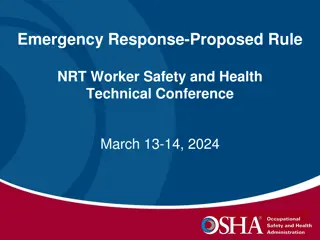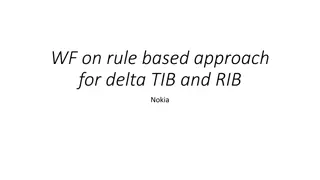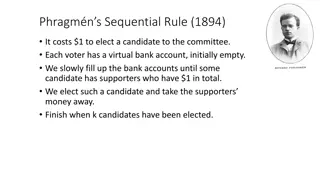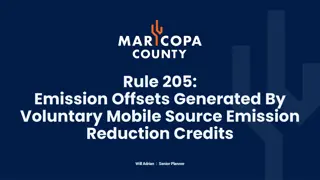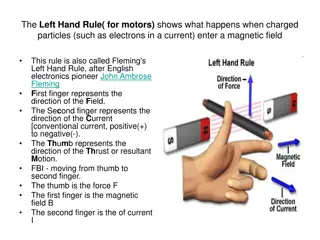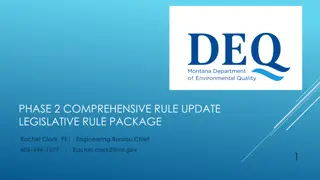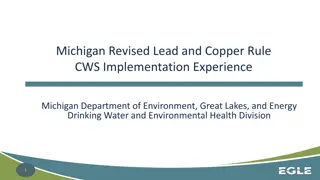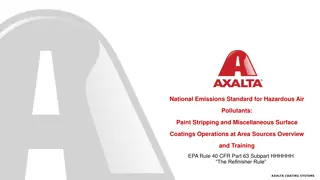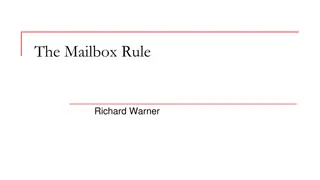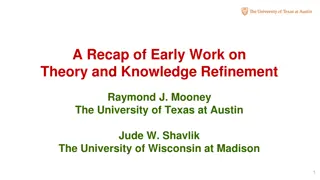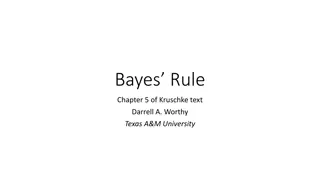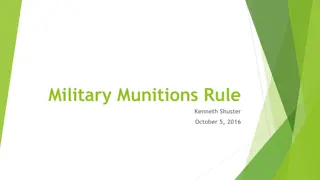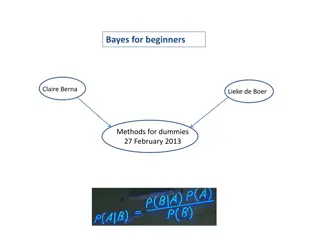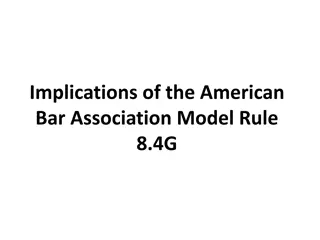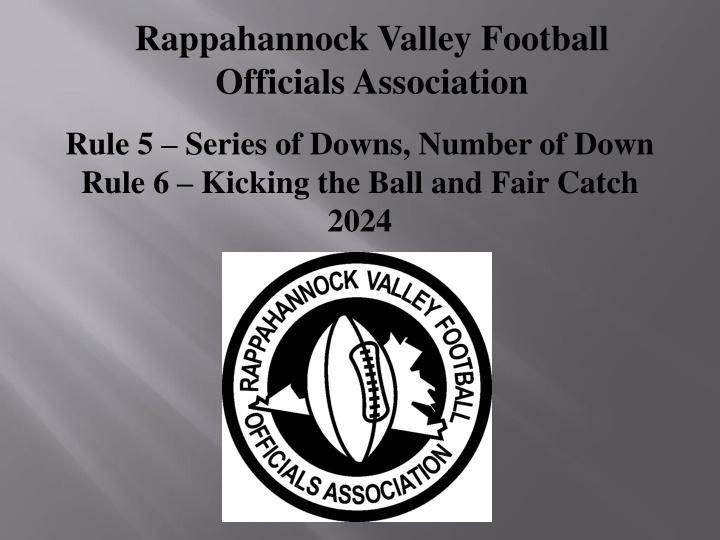
Rappahannock Valley Football Officials Association Rules and Situations 2024
Explore the rules and situations regarding downs, correcting errors, and awarding new series in football as outlined by the Rappahannock Valley Football Officials Association in 2024.
Download Presentation

Please find below an Image/Link to download the presentation.
The content on the website is provided AS IS for your information and personal use only. It may not be sold, licensed, or shared on other websites without obtaining consent from the author. If you encounter any issues during the download, it is possible that the publisher has removed the file from their server.
You are allowed to download the files provided on this website for personal or commercial use, subject to the condition that they are used lawfully. All files are the property of their respective owners.
The content on the website is provided AS IS for your information and personal use only. It may not be sold, licensed, or shared on other websites without obtaining consent from the author.
E N D
Presentation Transcript
Rappahannock Valley Football Officials Association Rule 5 Series of Downs, Number of Down Rule 6 Kicking the Ball and Fair Catch 2024
Rule 5 Incorrect Down 5.1.1 SITUATION A: What procedure is used to correct an error if it is discovered: (a) a fifth down has been run and the discovery is prior to the ball becoming live after a new series of downs is awarded and prior to the declaration of the end of any period; or (b) A has not been given its allotted four downs and the discovery is prior to the ball becoming live after a new series of downs is awarded and prior to the declaration of the end of any period? RULING: In both cases, the number of the next down can be corrected by the referee. In (a), play will revert to where it was before the fifth down was run after the enforcement of any personal, dead ball or unsportsmanlike fouls that occurred during the down. In (b), the referee can declare the proper next down and resume play. COMMENT: Even though play selection, etc. is determined by the down number displayed on the down marker indicator, the official number of the down is determined by the referee.
Rule 5 Incorrect Down 5.1.1 SITUATION B: Second down and six. On the last play of the third period, A38 gains three yards. After the play, the down-marker indicator is flipped to fourth down. Following a brief pause to ensure no reason to defer ending the quarter, the referee holds the ball over his head to signify the end of the period. Both teams change ends of the field and the chains are reversed. Before the ball is snapped for the first play of the fourth period, Team A s coach notifies the game officials that he believes there is an error in the down. RULING: The third period officially ended when the referee held the ball over his head, and therefore the down error may not be corrected.
Rule 5 Incorrect Down 5.1.1 SITUATION C: During a fifth-down play, Team A is flagged for: (a) illegal formation; (b) holding; (c) twisting the face mask; (d) taunting; or (e) fighting. RULING: The penalties are not enforced in (a) or (b). In (c), (d) and (e), the penalty is enforced as a dead-ball foul before Team B snaps the ball. In (e), the offending player is also disqualified.
Rule 5 Awarding a New Series 5.1.2 SITUATION A: Following the ready-for-play signal for a new series by A: (a) B1 encroaches, or (b) A1 false starts. RULING: In (a), it is first and 5, in (b), it is first and 15 for A.
Rule 5 Awarding a New Series 5.1.2 SITUATION B: During A1's run for a first down to B's 20-yard line, B12 commits a nonplayer foul for a substitute entering the field during the down, but not participating. Immediately following the down, A1 taunts an opponent. RULING: If accepted, the penalty for B entering during the down is enforced from the succeeding spot. After the decision on this penalty, A will be penalized 15 yards for unsportsmanlike conduct and A will have the ball for a new series, first and 10. (3-7-6, 9-5-1a)
Rule 5 Awarding a New Series 5.1.2 SITUATION C: Third and 10 for A from B's 40-yard line. A1 gains 10 yards and is downed on B's 30. A2 taunts B1 during the run. RULING: Since the live-ball action gave A a new series, the line to gain shall be established after A is penalized for A2's unsportsmanlike act. It will be first and 10 for A from B's 45-yard line. What would be the signals to the press box?
Rule 5 Awarding a New Series 5.1.2 SITUATION E: Fourth and 2 on B's 25-yard line. A1 is tackled at the 26, short of the line to gain, and B2 then piles on. RULING: The referee shall signal a change of possession by signaling first down toward A's goal. The penalty for B2's dead-ball foul is administered and the line-to-gain equipment is then set, making it first and 10 for B from its own 13-yard line. COMMENT: On fourth-down plays, A must get a first down by virtue of the yardage gained, including any yardage or an automatic first down from penalties for player fouls during the down, or it is a new series for B automatically when the down ends unless the down is to be repeated. The penalties for all unsportsmanlike and nonplayer fouls which occur during the down in which a new series is awarded, and dead-ball fouls prior to the subsequent ready-for-play signal, will be administered before the new line to gain is established and the chain and box are set. In all cases, it will be first and 10 for A unless it is inside the opponent's 10-yard line. On plays other than on fourth down, A may gain a first down by virtue of the yards gained or from penalty enforcement.
Rule 5 Effect of R Touch a Kick 5.1.3 SITUATION A: K1 s field-goal attempt is partially blocked behind the neutral zone, but deflects beyond the neutral zone and is then muffed by R1. The muffed ball is recovered: (a) behind, or (b) beyond the neutral zone by K2. RULING: In both (a) and (b), it is a first down for K. In (a), K2 could have advanced after recovering. (5-1-3f)
Rule 5 Effect of R Touching a Kick 5.1.3 SITUATION B: During a fourth-down scrimmage kick by K1 from K s 40, R1 is first to touch the kick beyond the neutral zone where he muffs it at R s 30-yard line. The kick is recovered by R2 at R s 10-yard line. Following the muff by R1, while the ball is loose, there is holding by K2. RULING: If the penalty is accepted by R, the down would either be replayed from K s 30-yard line or the yardage for the penalty would be added onto the end of the run per 10-4-2:Exception. If the penalty is declined, R will put the ball in play first and 10 from its 10-yard line, the spot of recovery. (5-1-3d)
Rule 5 Effect of R Touching a Kick 5.1.3 SITUATION C: Fourth and 10 on K s 45-yard line. K1 punts the ball beyond the neutral zone. R1 muffs the ball back behind the neutral zone where K1 recovers and: (a) falls on the ball at K s 40-yard line; or (b) throws a forward pass to K3 which is complete at the 50-yard line and R1 interferes with K3; or (c) K1 punts the ball and R1 fair catches at his 30-yard line. RULING: Since R1 touched the kick beyond the neutral zone, it will be first down for the team in possession in (a), (b) and (c). In (a), it is a first down for K at K s 40-yard line. In (b), the pass is legal as there had been no change of team possession. If K accepts the penalty for pass interference, it will be K s ball at R s 40-yard line. In (c), the second punt is legal as there had been no change of team possession. The ball belongs to R first and 10 on its own 30-yard line. (5-1-3f, 6-2- 1, 7-5-1)
Rule 5 Effect of R Touching a Kick 5.1.3 SITUATION D: K s ball, fourth and 2 at midfield. The scrimmage kick crosses the expanded neutral zone and is muffed by R at the R 40-yard line. The ball then bounds back behind the line of scrimmage and is recovered by K2 at K s 43-yard line. K2 advances to K s 49-yard line where he throws an incomplete pass to eligible receiver K80 at the R38. RULING: This is not an illegal forward pass as the ball was legally thrown behind the neutral zone. There has been no change of possession during the down. K is awarded a new series as the ball was touched by R beyond the expanded neutral zone and K is in possession at the end of the down. It will be K s ball, first and 10 at midfield due to the incomplete pass. (7-5-2, 2-34-3, 5-1- 3f, 7-5-5)
Rule 5 Team Possession After Penalty Enforcement 5.2.2 SITUATION A: With fourth and 5 from B's 30, A1 throws a forward pass that is intercepted by B1 on his 10-yard line and returned to B's 29. While the pass was in flight, ineligible A2 was illegally downfield, and the ball: (a)is muffed by A2 at the 12-yard line prior to being intercepted, or (b)did not touch A2 prior to the touching and interception by B1. RULING: In (a), A has committed two fouls - illegal touching and ineligible downfield. B1 will decline the ineligible downfield penalty to keep the football but will accept the penalty for illegal touching as the ball will be at B's 35 following enforcement and will be B's ball due to the loss of down foul. In (b), the foul carries a 5- yard penalty and B would then likely decline the penalty and keep the ball first and 10 from its own 29-yard line.
Rule 5 Team Possession After Penalty Enforcement 5.2.2 SITUATION B: With fourth down and 4 from the 50, A1 runs to B's 40 and then throws an incomplete forward pass. RULING: If B declines the penalty, it will be A's ball first and 10 from B's 40-yard line. If B accepts the 5-yard penalty for the illegal forward pass, it will still be a first down for A from B's 45-yard line. The loss of down part of the penalty has no significance since the succeeding spot is beyond the line to gain and a new series is awarded.
Rule 5 Team Possession After Penalty Enforcement 5.2.5 SITUATION: K1 punts the ball to R1. R1 catches the punt on his own 10-yard line and begins to advance. During the run, K1 grabs R1's face mask/helmet opening at R's 20-yard line. R1 continues to advance, but is hit and fumbles the ball on K's 10-yard line. K2 recovers the fumble on K's 5-yard line and K commits a dead ball foul. RULING: If R accepts the penalty for the face-mask/helmet opening foul, it will be enforced from the end of R1's run (the spot of the fumble), thus making it first and goal for R from K's 5-yard line. The dead-ball foul would be administered from that point making it first and goal for R from K's 2 -yard line. If R refuses the face- mask/helmet opening penalty, the ball would belong to K on K's 5- yard line. R then may accept the penalty for the dead-ball foul by K3 making it K's ball first and 10 from K's 2 -yard line. The box and chain are set following enforcement of the dead-ball foul. (5-2-1, 5-2- 5e)
Rule 5 Measurement 5.3.2 SITUATION B: Following a third-down play, the game officials do not measure as the referee judges the line to gain clearly has not been reached. A lines up in punt formation. Just before assuming his set position, the captain of A requests a measurement. RULING: The request is denied for two reasons. The captain must make a request for measurement before the ball is ready for play and no measurement is made if it is obvious the line to gain has not been reached. COMMENT: In any situation where there is doubt, game officials should measure. Following measurement in a side zone, the chain should be used to place the ball at the hash mark. (5-3-2 Note)
Rule 5 Ball on Goal Line 5.3.4 SITUATION A: With first and 10 from A's 4-yard line, A1 is tackled and the ball is lying on the 5-inch line with its long axis parallel to the goal line. How is the ball to be spotted? RULING: The referee will, by rule, rotate and place the ball so that its rear point is not penetrating the plane of A's goal line. The ball is rotated with its rearmost point moved forward just enough so it isn't touching the goal line. A gains a few inches in the process.
Rule 5 Ball on Goal Line 5.3.4 SITUATION B: A1 receives the snap behind his own goal line. A1 advances, but is tackled and the ball becomes dead with its foremost point in the field of play, but part of the ball is in the end zone. RULING: Safety. To avoid a safety, the ball must be advanced completely out of the end zone with no part of it touching the goal line. (8-5-2)
**Rule 6 Free Kick Formations 6.1.3 SITUATION A: After the ready for play and prior to the ball being kicked, Team K has five players to the left of the kicker and five players to the right of the kicker with the ball spotted at the K40. The potential kicker, K1, is lined up at the K32 to begin his kick and all other K players are clearly outside of the K35. As K1 approaches the kick, he suddenly slows down and K2 then kicks an onside kick that is recovered by R1. RULING: Team K has committed a foul for encroachment and the ball shall be blown dead immediately. R is given the option to accept the distance penalty of 5 yards for the dead-ball foul.
Rule 6 Recovery by K 6.1.6 SITUATION A: A kickoff by K1 from K's 40 is muffed by R1 near his 20- yard line. The muff is caught by K2 at the 18 and he advances into R's end zone. RULING: It will be K's ball first and 10 from R's 18. K2 may catch or recover the muffed kick but may not advance. The ball is dead when K gains possession. The covering official should sound his whistle to stop play - immediately when the ball becomes dead.
Rule 6 First Touching of a Free Kick Is first touching by K on a free kick a foul? No. First touching by K gets a bean bag for the spot of first touching, not a penalty flag. Can K catch a pooch kick as long as it goes 10 yards and there are no R players in the area? No. An ungrounded kick cannot be caught by K. The penalty is Kick Catching Interference
Rule 6 Causing a Free Kick to be Out of Bounds 6.1.9 SITUATION B: The free kick by K1 from K s 40-yard line: (a) is touched by R1 at R s 5 and goes out of bounds at the 8-yard line; or (b) is muffed by R1 at his 15 and then touched by K2 before it rolls out of bounds at R s 10-yard line; or (c) bounces out of bounds on R s 40-yard line untouched by R or K. RULING: In (a) and (b) the ball belongs to R at the inbounds spot. In (c), it is a foul by K. The receivers may take the ball at the inbounds spot, take the ball at R s 35 which is 25 yards beyond the previous spot, take the ball at R s 45 which is the out of bounds spot plus the five- yard penalty or accept the 5-yard penalty and have K free kick from K s 35-yard line. (2-41-4, 6-1-10)
Rule 6 Causing a Free Kick to be out of Bounds 6.1.9 SITUATION D: K1 tries an onside kick from K's 40, as the ball bounces near the sideline the ball is muffed out-of-bounds by K2 at R's 49. RULING: R could have K rekick after a five-yard penalty or take the ball 1st and 10 at the inbounds spot at R s 49 or take the ball 1st and 10 at the inbounds spot at R s 35,or five yards from the succeeding spot.
Rule 6 Causing a Free Kick to be out of Bounds 6.1.9 SITUATION F: K1 tries an onside kick from K's 40. K2 muffs the ball at K's 48, and the ball bounces off R and is muffed out of bounds by K3 at R's 45. K did not force the ball into R. RULING: R can either choose to take the ball at K's 48 at the spot of first touching or at R's 45 where the ball went out of bounds. The free kick was touched by R, so R has no re-kick option.
Rule 6 Touching and Recovering Scrimmage Kicks 6.2.3 SITUATION B: With third and 10 on K's 10-yard line, K1's punt is blocked and recovered on K's 4-yard line: (a) simultaneously by K2 and R1, or0 (b) by K2 who advances to K's 15. RULING: In (a), the ball is dead immediately and is awarded to R because of the joint recovery(Table 6-4-4) In (b), since K may recover in or behind the neutral zone and advance, it is fourth and 5 for K from its own 15-yard line. The series for K did not end because the kick was blocked. (4-2-2e)
Rule 6 Touching and Recovering Scrimmage Kicks 6.2.5 SITUATION C: With fourth and 5 from K's 30-yard line, K9 punts the ball downfield where it is grounded and touched by K88 (first touching) at R's 30. The ball continues rolling and is picked up by R35 at R's 25-yard line. R35 is subsequently hit and fumbles at R's 28. The loose ball is recovered by K88 on the ground at R's 26. During the kick, R55 is flagged for holding. RULING: If K accepts R's foul for holding, then it is enforced from the previous spot since post scrimmage kick cannot apply as K is next to put the ball in play as a result of the recovered fumble. Also, if K accepts the foul, the awarded spot for first touching is not applied. If K declines R's foul, R will take the ball at the spot of first touching. (2-12-1, 2-12-2, 2-16-2h)
Rule 6 Simultaneous Recovery 6.2.7 SITUATION: Fourth and 3 for K from their own 10-yard line. A scrimmage kick by K1 is muffed in flight prior to being grounded beyond the neutral zone by R1 and rebounds back into K's end zone where it is simultaneously recovered by opposing players. RULING: Touchdown for R. If K is in possession in K's end zone at the end of the down, it is a safety. If R is in possession or if there is joint possession, it is a touchdown. The ball is awarded to R when any scrimmage kick is out of bounds between the goal lines, becomes dead inbounds between the goal lines while no player is in possession or becomes dead inbounds anywhere while opponents are in joint possession. Since the kick was muffed beyond the neutral zone and there has been no possession, it is still a kick into K's own end zone. (4-2-2e, 8-2-1b)
Rule 6 Kicks into Rs End Zone - Touchback 6.3.1 SITUATION A: A scrimmage kick by K1 comes to rest on R's 6-yard line. R1 attempts to recover and advance, but muffs the ball so that it rolls into the end zone where: (a) R2 downs the ball; or (b) R3 recovers and advances out of the end zone; or (c) K2 recovers and downs the ball in the end zone. RULING: The ball became dead as soon as it broke the plane of R's goal line. It is a touchback in (a), (b) and (c). The kick had not ended because muffing does not constitute possession, therefore, it is a kick into R's end zone which is an automatic touchback. The covering official should sound the whistle immediately when the ball becomes dead as a result of breaking the goal-line plane. Force is not a factor on kicks going into R's end zone. R will put the ball in play, first and 10, from their 20-yard line. (2-24-2, 8-5-3a)
Rule 6 Fair Catch Signal During Kick 6.5.1 SITUATION A: R1 and R2 both signal for a fair catch and: (a) the punt is short and is caught by R3; or (b) the punt is over the head of R1, and R2 blocks K1 who is attempting to down the ball near the goal line; or (c) R2 muffs the punt which is then muffed by K2 and finally recovered by R1. RULING: R3 did not make a fair catch in (a), but the ball became dead when it was caught. In (b), it is an illegal block because R2 blocked before the kick ended after giving a signal and the penalty, if accepted, will be administered from the post-scrimmage kick spot. In (c), the ball became dead as soon as R1 recovered. (4- 2-2g, 6-5-5, 9-3-3)
Rule 6 Fair Catch Signal During Kick 6.5.3 SITUATION: R1 signals for a fair catch of a scrimmage kick by K1. Teammate R2 catches the kick and is tackled immediately by K1 who did or did not have a chance to see the signal. The contact which was not a personal foul occurred before the covering official sounded his whistle. R2 fumbles when tackled and the ball is recovered by K2. RULING: The ball became dead when it was caught by R2. The contact by K1 was not a foul because R2 did not signal for a fair catch. R2 fumbled a dead ball and there could be no recovery by K2. COMMENT: Contacting a receiver who did not give a fair-catch signal or contacting a receiver who has given a signal but is contacted where he cannot make a fair catch, is not a foul unless the contact is judged by the game official to be a personal foul. The receiver is not afforded special protection in such situations. Members of the kicking team have the responsibility for knowing when the ball is dead. If a kicker could not have seen a fair-catch signal made by the teammate of the receiver, there is no foul. However, if he could have seen the signal, he does not have license to contact the receiver. (4-2-2g)
Rule 6 Choice to Snap or Free Kick (Rule 6) 6.5.4 SITUATION: R1 signals for a fair catch beyond the neutral zone on K s 40. K2 interferes with R1 s opportunity to make the catch. R chooses an awarded catch and to put the ball in play with a snap. During the next down: (a) A1 gains 15 yards and the coach of B is charged with an unsportsmanlike foul; or (b) B2 commits pass interference; or (c) an inadvertent whistle sounds during A1 s forward pass. RULING: In (a), the unsportsmanlike foul during the down does not give A another choice to snap or free kick. However in (b), A may snap or free kick following penalty enforcement. In (c), the down is replayed and A has the option to snap or free kick. (10-4-5a)
Rule 6 - Kick Catch Interference 6.5.6 SITUATION A: K2's punt is partially blocked by R1 in or behind the neutral zone and it then travels beyond the neutral zone. R2 is in position to catch the ball, but it first touches K2's shoulder before hitting the ground where it is recovered by R2. RULING: Since R1's touching is ignored, it is kick- catching interference by K2, because R2 was in position to catch the ball.
Rule 6 Kick Catch Interference 6.5.6 SITUATION B: K1's punt is coming down over R's 15-yard line and (a) R2 is in position to catch the ball, or (b) all R players have moved away from where the ball will land. In both (a) and (b), K3 catches the ball. RULING: In (a), it is kick-catching interference and R has the option to take the results of the play or accept the 15- yard penalty for kick-catching interference. If the distance penalty is accepted, it is R's choice to have the penalty enforced from the spot of the foul or to have it enforced from the previous spot and require K to rekick. In (b), the play is legal, and the ball is dead as soon as K3 catches it. The spot of the catch is also a spot of first touching and R will put the ball in play on that yard line, first and 10.
Rule 6 Kick Catch Interference 6.5.6 SITUATION D: K1 s punt is high but short. R2, from well down field, runs toward the ball to get in position to attempt to catch it. K2 is also moving toward the ball or just standing there when: (a) K2 is contacted by R2; or (b) K2 causes R2 to veer away from the ball but there is no contact by K2. The ball strikes the ground and is recovered by R3. RULING: K2 has committed kick catching interference in both (a) and (b) since K2 did not provide R2 an unobstructed opportunity to catch the ball. R may choose to take the results of the play, or accept the 15- yard penalty for kick-catching interference. If the distance penalty is accepted, it is R s choice to have the penalty enforced from the spot of the foul or to have it enforced from the previous spot and require K to replay the down.
What is the difference between an invalid fair-catch signal and an illegal fair-catch signal? An invalid fair-catch signal is any signal by a receiver before the kick is caught or recovered: a. That does not meet the requirements of a valid signal b. After the kick has touched a receiver(muff) c. After the kick has touched the ground An illegal fair-catch signal is any signal by a runner: a. After the kick has been caught b. After the kick has been recovered
Rule 6 Illegal Signal by Runner 6.5.8 SITUATION A: R1 catches K1's punt and then quickly gives a fair-catch signal after advancing a couple of steps. RULING: An illegal fair-catch signal by R1. The spot of the illegal signal is the spot of the foul for enforcement under 10-4.(2-9-5) Note: The play is not dead when the receiver gives the fair catch signal. He can continue to advance and is allowed to be tackled without penalty, as long as the contact is not a personal foul.


